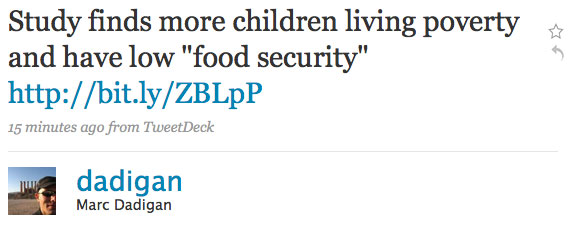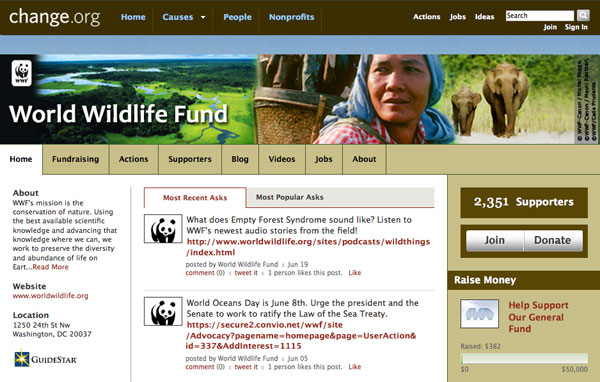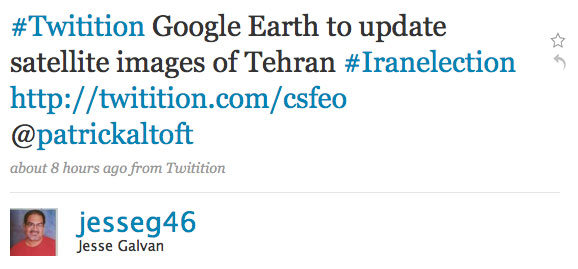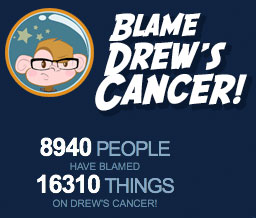This post is a collaboration between Mashable’s Summer of Social Good charitable fundraiser and Max Gladwell‘s “10 Ways” series. The post is being simultaneously published across more than 100 blogs.

Social media is about connecting people and providing the tools necessary to have a conversation. That global conversation is an extremely powerful platform for spreading information and awareness about social causes and issues. That’s one of the reasons charities can benefit so greatly from being active on social media channels. But you can also do a lot to help your favorite charity or causes you are passionate about through social media.
Below is a list of 10 ways you can use social media to show your support for issues that are important to you. If you can think of any other ways to help charities via social web tools, please add them in the comments. If you’d like to retweet this post or take the conversation to Twitter or FriendFeed, please use the hashtag #10Ways.
1. Write a Blog Post
Blogging is one of the easiest ways you can help a charity or cause you feel passionate about. Almost everyone has an outlet for blogging these days — whether that means a site running WordPress, an account at LiveJournal, or a blog on MySpace or Facebook. By writing about issues you’re passionate about, you’re helping to spread awareness among your social circle. Because your friends or readers already trust you, what you say is influential.
Recently, a group of green bloggers banded together to raise individual $1 donations from their readers. The beneficiaries included Sustainable Harvest, Kiva, Healthy Child, Healthy World, Environmental Working Group, and Water for People. The blog-driven campaign included voting to determine how the funds would be distributed between the charities. You can read about the results here.
You should also consider taking part in Blog Action Day, a once a year event in which thousands of blogs pledge to write at least one post about a specific social cause (last year it was fighting poverty). Blog Action Day will be on October 15 this year.
2. Share Stories with Friends

Another way to spread awareness among your social graph is to share links to blog posts and news articles via sites like Twitter, Facebook, Delicious, Digg, and even through email. Your network of friends is likely interested in what you have to say, so you have influence wherever you’ve gathered a social network.
You’ll be doing charities you support a great service when you share links to their campaigns, or to articles about causes you care about.
3. Follow Charities on Social Networks
In addition to sharing links to articles about issues you come across, you should also follow charities you support on the social networks where they are active. By increasing the size of their social graph, you’re increasing the size of their reach. When your charities tweet or post information about a campaign or a cause, statistics or a link to a good article, consider retweeting that post on Twitter, liking it on Facebook, or blogging about it.
Following charities on social media sites is a great way to keep in the loop and get updates, and it’s a great way to help the charity increase its reach by spreading information to your friends and followers.
You can follow the Summer of Social Good Charities:
Oxfam America (Twitter, Facebook, MySpace, Flickr, YouTube) The Humane Society (Twitter, Facebook, YouTube, MySpace, Flickr) LIVESTRONG (Twitter, Facebook, MySpace, YouTube, Flickr) WWF (Twitter, Facebook, YouTube, Flickr)
And don’t forget to keep up with your favorite nonprofit green news site (that would be Grist!):
Grist.org (Twitter, Facebook, MySpace, YouTube, Flickr)
4. Support Causes on Awareness Hubs

Another way you can show your support for the charities you care about is to rally around them on awareness hubs like Change.org, Care2, or the Facebook Causes application. These are social networks or applications specifically built with nonprofits in mind. They offer special tools and opportunities for charities to spread awareness of issues, take action, and raise money.
It’s important to follow and support organizations on these sites because they’re another point of access for you to gather information about a charity or cause, and because by supporting your charity you’ll be increasing their overall reach. The more people they have following them and receiving their updates, the greater the chance that information they put out will spread virally.
5. Find Volunteer Opportunities
Using social media online can help connect you with volunteer opportunities offline, and according to web analytics firm Compete, traffic to volunteering sites is actually up sharply in 2009. Two of the biggest sites for locating volunteer opportunities are VolunteerMatch, which has almost 60,000 opportunities listed, and Idealist.org, which also lists paying jobs in the non-profit sector, in addition to maintaining databases of both volunteer jobs and willing volunteers.
For those who are interested in helping out when volunteers are urgently needed in crisis situations, check out HelpInDisaster.org, a site which helps register and educate those who want to help during disasters so that local resources are not tied up directing the calls of eager volunteers. Teenagers, meanwhile, should check out DoSomething.org, a site targeted at young adults seeking volunteer opportunities in their communities.
6. Embed a Widget on Your Site
Many charities offer embeddable widgets or badges that you can use on your social networking profiles or blogs to show your support. These badges generally serve one of two purposes (or both). They raise awareness of an issue and offer up a link or links to additional information. And very often they are used to raise money.
Mashable’s Summer of Social Good campaign, for example, has a widget that does both. The embeddable widget, which was custom built using Sprout (the creators of ChipIn), can both collect funds and offer information about the four charities the campaign supports.
![]()
7. Become a Climate Citizen
Grist is partnering with climate activism group 1Sky and everyday citizens like yourself to track the openness of U.S. lawmakers on climate change.
Send Grist hot tips on what legislators and businesses in your region are saying about a climate and energy bill via Facebook, Twitter, or email. Find your senators’ YouTube channels and see if they have made any video statements about how they’ll vote on climate. And spread the word about via your own social networks.
8. Express Yourself Using Video
As mentioned, blog posts are great, but a picture really says a thousand words. The web has become a lot more visual in recent years and there are now a large number of social tools to help you express yourself using video. When you record a video plea or call to action about your issue or charity, you can make your message sound more authentic and real. You can use sites like 12seconds.tv, Vimeo, and YouTube to easily record and spread your video message.
Last week, the Summer of Social Good campaign encouraged people to use video to show support for charity. The #12forGood campaign challenged people to submit a 12 second video of themselves doing something for the Summer of Social Good. That could be anything, from singing a song to reciting a poem to just dancing around like a maniac — the idea was to use the power of video to spread awareness about the campaign and the charities it supports.
If you’re more into watching videos than recording them, Givzy.com enables you to raise funds for charities like Unicef and St. Jude’s Children’s Hospital by sharing viral videos by e-mail.
Looking for inspiration? Check out the wacky video antics Grist recorded in its latest fundraising drive:
9. Sign or Start a Petition

There aren’t many more powerful ways to support a cause than to sign your name to a petition. Petitions spread awareness and, when successfully carried out, can demonstrate massive support for an issue. By making petitions viral, the social web has arguably made them even more powerful tools for social change. There are a large number of petition creation and hosting web sites out there. One of the biggest is The Petition Site, which is operated by the social awareness network Care2, or PetitionOnline.com, which has collected more than 79 million signatures over the years.
Petitions are extremely powerful, because they can strike a chord, spread virally, and serve as a visual demonstration of the support that an issue has gathered. Social media fans will want to check out a fairly new option for creating and spreading petitions: Twitition, an application that allows people to create, spread, and sign petitions via Twitter.
10. Organize an Online Event
Social media is a great way to organize offline, but you can also use online tools to organize effective online events. That can mean free form fund raising drives, like the Twitter-and-blog-powered campaign to raise money for a crisis center in Illinois last month that took in over $130,000 in just two weeks. Or it could mean an organized “tweet-a-thon” like the ones run by the 12for12k group, which aims to raise $12,000 each month for a different charity.
In March, 12for12k ran a 12-hour tweet-a-thon, in which any donation of at least $12 over a 12 hour period gained the person donating an entry into a drawing for prizes like an iPod Touch or a Nintendo Wii Fit. Last month, 12for12k took a different approach to an online event by holding a more ambitious 24-hour live video-a-thon, which included video interviews, music and sketch comedy performances, call-ins, and drawings for a large number of prizes given out to anyone who donated $12 or more.
Bonus: Think Outside the Box

Social media provides almost limitless opportunity for being creative. You can think outside the box to come up with all sorts of innovative ways to raise money or awareness for a charity or cause. When Drew Olanoff was diagnosed with cancer, for example, he created Blame Drew’s Cancer, a campaign that encourages people to blow off steam by blaming his cancer for bad things in their lives using the Twitter hashtag #BlameDrewsCancer. Over 16,000 things have been blamed on Drew’s cancer, and he intends to find sponsors to turn those tweets into donations to LIVESTRONG once he beats the disease.
Or check out Nathan Winters, who is biking across the United States and documenting the entire trip using social media tools, in order to raise money and awareness for The Nature Conservancy.
The number of innovative things you can do using social media to support a charity or spread information about an issue is nearly endless. Can you think of any others? Please share them in the comments.
Special thanks to VPS.net

A special thanks to VPS.net, who are donating $100 to the Summer of Social Good for every signup they receive this week.
Sign up at VPS.net and use the coupon code “SOSG”to receive 3 Months of FREE hosting on top of your purchased term. VPS.net honors a 30 day no questions asked money back guarantee so there’s no risk.
About the “10 Ways” Series
The “10 Ways” Series was originated by Max Gladwell. This is the second simultaneous blog post in the series. The first ran on more than 80 blogs, including Mashable and Grist. Among other things, it is a social media experiment and the exploration of a new content distribution model. You can follow Max Gladwell on Twitter.
This content was originally written by Mashable’s Josh Catone and edited by Grist’s Ashley Braun.



